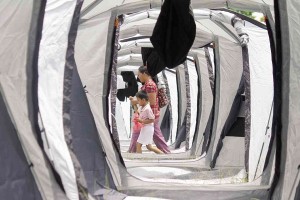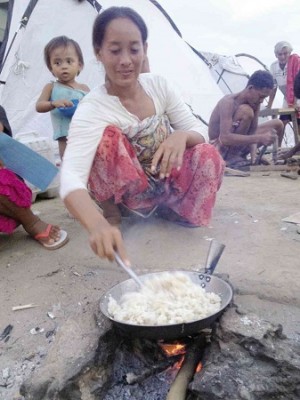Tent city for evacuees alien land for Badjaos
ZAMBOANGA CITY—Elisa Mangilahe, a Badjao and mother of two children, hurriedly roasts a kilogram of sianglag (freshly processed cassava) as she tries to beat the “no cooking after 6 p.m.” policy on RT Lim Boulevard.

RESIDENTS displaced by the fighting try to find their way through a maze of tents set up for thousands of people who are caught in the crossfire. KARLOS MANLUPIG
The sianglag will be dinner and breakfast for her husband and two children.
“Ito yung bigas namin (This is our rice),” the 30-year-old Mangilahe said.
Next to Mangilahe’s tent is Pormita Estok, 22, who is frying four pieces of squid which will be shared by her two children and husband.
In the next tent, Carolina Keblangan is tending her small sari-sari store. “Money for coffee. Also for milk and water for my baby,” she said.
Article continues after this advertisementKeblangan and several Badjao women have set up mini stores, selling charcoal and repacked cooking oil, sugar and salt.
Article continues after this advertisementResiliency
Zenaida Arevalo, the acting regional director of the Department of Social Welfare and Development (DSWD), said the Badjao evacuees have shown “high resiliency in this crisis.”
“They bounce back quickly,” Arevalo said, adding that Badjaos have asked the DSWD officials to allow them to cook their own food.
“They’re fed up with chicken,” she said, referring to the usual content of the packed food being distributed to the evacuees.
The Badjaos also asked the DSWD to provide them with cassava instead of rice.
“We are moving around barangays to get more cassava for them,” Arevalo said.

A BADJAO woman cooks food for her family, trying to beat the 6 p.m. deadline for cooking food in the tent city. JULIE S. ALIPALA
The Badjaos stay on RT Lim Boulevard, outside Don Joaquin Memorial Sports Complex where some 70,000 evacuees are housed.
Rohana Jalain, 24, and a mother of three, said that on the first two days of their stay in the evacuation center, she tried lining up for food.
“It’s hard waiting for food to be distributed. My children went hungry. That’s why I thought of cooking food myself,” Jalain said.
“And we Badjaos are used to eating cassava,” she said.
Chicken and rice
Medisina Mohammad said her husband Rijiki goes fishing “so we will have something to eat.”
“We are tired of eating chicken and rice,” Mohammad, a mother of seven children, said.
At 5 p.m., while the sun is still up, Badjao mothers start cooking for their families. An hour later, they are prohibited from doing so to prevent the tents from catching fire.
Inside the sports complex, however, evacuees are not allowed to cook their own food.
“Those are tents they’re living in and it’s not advisable to cook there,” Arevalo said.
Nene Usman, one of the social welfare officers at the sports complex, said there are more than 70,000 evacuees inside the sports complex while at least 30,000 others, including Badjaos on RT Lim Boulevard, are scattered in 33 evacuations centers.
Darlene de la Cruz, a mother of four and among the thousands of evacuees at the sports complex, said she wanted to return to her home because life is so hard in the evacuation center.
“We may be safe here, but it’s really hard for us here,” said De la Cruz, whose husband works at the city health office.
De la Cruz said she wants to cook for her children, but can’t because “the tents here are so close to each other.”
Arevalo said the DSWD is thinking of ways to allow the women to cook for their children.
“For now, we have to rely on the service providers,” she said.

